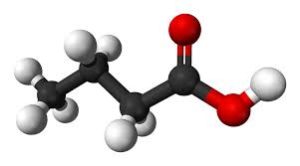Butyric Acid Formula
Butyric acid is having 4 carbon atoms, and from the Greek word, its meaning is butter. Lieben and Rossi in 1869 have discovered it. It is a saturated fatty acid and it is a member of the sub-group and known as in short as chain fatty acids up to 6 carbon atoms. Butyric Acid is a type of colorless liquid fatty-acid. The main reason for this unpleasant odor is due to butter and animal fats. Its main sources are plant oils, butter, animal fat, breast milk, bovine milk, and parmesan cheese. Salts and esters of Butyric Acid are known as butyrates or butanoates too. This article will explain the Butyric Acid formula with examples. Let us learn it!

Source: en.wikipedia.org
Butyric Acid Formula
What is Butyric Acid?
Butyric acid is also called as butanoic acid. It is a fatty acid occurring in the form of esters in animal fats and plant oils also. As a glyceride, it makes up 3 to 4 percent of butter; the disagreeable odor of rancid butter is that of hydrolysis of the butyric acid glyceride.
This acid is of considerable commercial importance and uses as a raw material in the manufacture of esters of lower alcohols. It is useful to make cellulose butyrate, as a useful plastic. Butyric acid is manufactured by the catalyzed air oxidation of butanal i.e butyraldehyde.
The formula for Butyric Acid:
In expanded form,
Its manufacturing chemical equation is:
Properties:
Butyric Acid is a saturated short-chain fatty acid that features a 4 – carbon backbone structure. It is a colorless liquid and is soluble in water and miscible with common organic solvents. It freezes at −7.9 degree C and it boils at 163.5 degrees C.
It’s one isomer 2-methylpropanoic i.e. isobutyric acid which is
Butyric acid is a member of the class of compounds that we commonly know as straight-chain fatty acids. These are fatty acids with a straight chain of aliphatic. Therefore, we consider it to be a fatty acid lipid molecule. It is available in a number of food items like cinnamon, pepper, burdock, and mandarin orange.
We find Butyric acid also in most biofluids, including saliva, breast milk, feces, and cerebrospinal fluid (CSF). Butyric acid exists in all eukaryotes, ranging from yeast to humans. In humans, it is butyric acid which is involved in a couple of metabolic pathways.
If this compound enters into the eyes, then we need to wash it with large quantities of isotonic saline or water.
Butyric Acid Uses:
The acid is of considerable commercial importance as the raw material in the manufacture of esters of lower alcohols. It is for the usage as flavoring agents. Its anhydride is useful to make the cellulose butyrate, a useful plastic. Its other names are:
- butyrate or ethyl acetic acid
- propylformic acid
- butanoate
- 2-butanoate
- 1-propanecarboxylic acid
Solved Examples:
Q.1: Compute the molar mass of Butyric Acid.
Solution: Its formula is:
Its molar mass will be:
=
= 88.10512 gram per mol.
Thus molar mass is 88.10512 gram per mole.